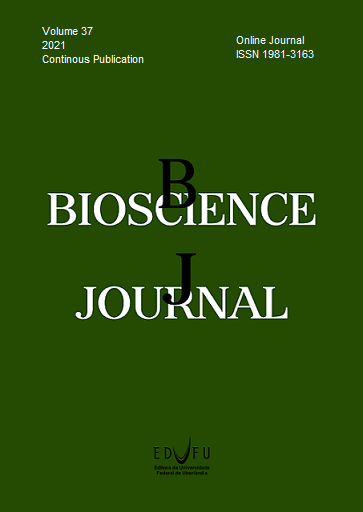Comparison of the spermatogenic process in three different mice strains: Swiss, Balb/C and C57BL/6
DOI:
https://doi.org/10.14393/BJ-v37n0a2021-54161Keywords:
Germ Cells, Male Reproduction, Morphometry, Spermatogenesis, Testis.Abstract
Many studies have been trying to establish standard protocols for animal experimentation, especially for animal species or strains, to master research variables with high precision. The main mouse strains used in the field of the biology of reproduction are Swiss, Balb/c, and C57BL/6. Since some of the strains show reproduction limitations, such as the size of the litter, the present study aimed to compare their spermatogenic processes to verify differences regarding the testicular parenchyma and germ cell populations, which could explain low offspring production. In addition, the present study provides additional information concerning the testicular parenchyma of such strains, which consequently would help researchers to choose the most suitable strain for reproductive studies. Six adult male mice were used for each of the strains. After euthanasia, the testes were weighed, fixated with Karnovsky fixative, embedded in methacrylate, sectioned, and stained with toluidine blue/sodium borate 1%. Morphometrical analyses from the testicular parenchyma (seminiferous tubules and interstitium) were made using the software ImageJ. Germ and Sertoli cells populations were counted in seminiferous tubules cross-sections at stage I of the seminiferous epithelium cycle. The lowest body and testicular weights were observed in C57BL/6 animals, followed by Balb/c and Swiss, however, the relative testes, parenchyma, and albuginea weights were significantly lower only in C57BL/6. Despite the seminiferous tubules and seminiferous epithelium proportions were lower in Swiss animals, their relative amount related to the body weight was the same among strains. The total number of germ cells was higher in Swiss animals, reflecting higher spermatogenic yield and daily sperm production. Due to the lower relative number of Sertoli cells, the Swiss animals showed the highest Sertoli cell index and support capacity. On the other hand, the lowest pathological indexes regarding the germ cells were observed in Balb/c animals, followed by Swiss and C57BL/6. In the interstitium, the proportion of blood vessels was lower in Swiss mice, while the lymphatic cell proportion was lower in C57BL/6 animals. Moreover, the highest proportions of Leydig cells and macrophages were noticed in Swiss mice, which may indicate increased testosterone levels. Altogether, such observations must be taken into account when choosing any of the studied strains for reproduction studies.
Downloads
References
ALMEIDA, S.A., et al. Valores de referência de parâmetros bioquímicos no sangue de duas linhagens de camundongos. Jornal Brasileiro de Patologia e Medicina Laboratorial. 2008, 44(6), 429–432. https://doi.org/10.1590/S1676-24442008000600006
AMANN, R. The male rabbit. IV. Quantitative testicular histology and comparisons between daily sperm production as determined histologically and daily sperm output. Fertility and Sterility. 1970, 21, 662–672.
AMANN, R. and ALMQUIST, J. Reproductive capacity of dairy bulls. VIII. Direct and indirect measurement of testicular sperm production. Journal of Dairy Science. 1962, 45(6), 774–781. https://doi.org/10.3168/jds.S0022-0302(62)89487-9
AMANN, R.P. and SCHANBACHER, B.D. Physiology of male reproduction. Journal of Animal Science. 1983, 57, 380–403.
ATTAL J, C.M. Développement testiculaire et établissement de la spermatogenèses chez le taureau. Annales de biologie animale, biochimie, biophysique. 1963, 3, 219–241.
BERNDTSON, W.E. Methods for quantifying mammalian spermatogenesis: a review. Journal of Animal Science. 1977, 44(5), 818–833. https://doi.org/10.2527/jas1977.445818x
BRAGA, L.M.G.M. Reproductive control in rodents animals facilities. Revista Brasileira de Reprodução Animal. 2017, 41(1), 105–109.
CRUZ, C.D. Programa Genes - Diversidade Genética. 1st ed. Viçosa: Editora UFV, 2008.
DIAS, F.C.R., et al. Hydroalcoholic extract of Pfaffia glomerata alters the organization of the seminiferous tubules by modulating the oxidative state and the microstructural reorganization of the mice testes. Journal of Ethnopharmacology. 2019, 233, 179–189. https://doi.org/10.1016/j.jep.2018.12.047
Dorst, J. and Sajonski, H. Morphometrische untersuchunhen am tubulussystem des schweinehodens während der postnatalen entwicklug. Monatshefte fur Veterinarmedizin. 1974, 29, 650–652.
FERNANDES, S.T., et al. Influência da temperatura e do tempo de armazenamento das dosagens bioquímicas de uréia e creatinina em soro ou plasma caninos. Arquivo Brasileiro de Medicina Veterinária e Zootecnia. 2001, 53(6), 1–7. https://doi.org/10.1590/S0102-09352001000600004
FRANÇA, L.R. and CARDOSO, F.M. Duration of spermatogenesis and sperm transit time through the epididymis in the Piau boar. Tissue and Cell. 1998, 30(5), 573–582. https://doi.org/10.1016/S0040-8166(98)80038-4
FRANÇA, L.R. and RUSSELL, L.D. ) The testis of domestic animals. In: REGADERA, J. and MARTINEZ-GARCIA, F. (Ed). Male reproduction: A multidisciplinary overview. Madrid: Churchill Communications, 1998.
GREEN, E. Biology of the laboratory mouse. New York: Mc Graw-Hill, 1986.
HALES, D.B. Testicular macrophage modulation of Leydig cell steroidogenesis. Journal of Reproductive Immunology. 2002, 57(1–2), 3–18. https://doi.org/10.1016/s0165-0378(02)00020-7
HALES, D.B., et al. Role of cytokines in testicular function. Endocrine. 1999, 10(3), 201–217. https://doi.org/10.1007/BF02738619
HOCHEREAU-DE REVIERS, M.T. and LINCOLN, G.A. Seasonal variation in the histology of the testis of the red deer, Cervus elaphus. Journal of Reproduction and Fertility. 1978, 54(1958), 209–213 https://doi.org/10.1530/jrf.0.0540209
JOHNSON, L., et al. A New Approach to Quantification of Spermatogenesis and Its Application to Germinal Cell Attrition During Human Spermiogenesis1. Biology of Reproduction. 1981, 25(1), 217–226. https://doi.org/10.1095/biolreprod25.1.217
JOHNSTON, S.L., et al. Associations between basal metabolic rate and reproductive performance in C57BL/6J mice. Journal of Experimental Biology. 2006, 210(1), 65–74. https://doi.org/10.1242/jeb.02625
KARNOVSKY, M.J. A formaldehyde-glutaraldehyde fixative of high osmolality for use in electron microscopy. Journal of Cell Biology. 1965, 27, 137-138.
MAGALHÃES, L. A ciência e os animais de laboratório. Revista da Sociedade Brasileira de Ciência em Animais de Laboratório. 2012, 1(1), 7–13.
MAIA, J.M.A, et al. Healing process in bladder suture of rats with and without the administration of intraperitoneal Jatropha gossypiifolia L. gross extract. Acta Cirurgica Brasileira. 2006, 21(Suplemento 2), 23–30. https://doi.org/10.1590/S0102-86502006000800005
MCGARIGAL, K., et al. Multivariate statistic for wildlife and ecology research. 1st ed. New York: Springer-Verlag, 2000. https://doi.org/10.1007/978-1-4612-1288-1
OLIVEIRA, C.F.A. Estudo comparado da função testicular de camundongos adultos BALB/c selvagens e portadores de mutação nos genes Foxn1 e Prkdc. Dissertação (mestrado em Biologia Celular) - Universidade Federal de Minas Gerais, Belo Horizonte, 2014.
Downloads
Published
How to Cite
Issue
Section
License
Copyright (c) 2021 Fernanda Carolina Ribeiro Dias, Jullyana Costa Machado, Sérgio Luis Pinto da Matta, Angelica de Oliveira Gomes, Marcos de Lucca Moreira Gomes

This work is licensed under a Creative Commons Attribution 4.0 International License.





